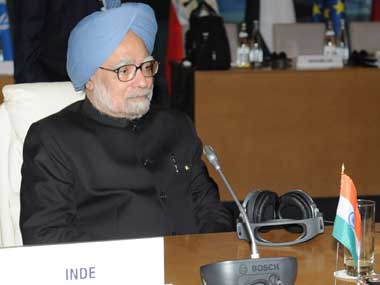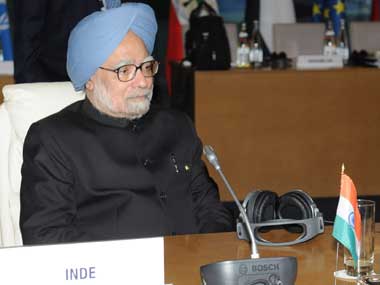By Senthil Chengalvarayan
Don’t shoot me, Mr Mukherjee, Dr Singh. What I have to say has nothing to do with the lack of reforms, which, we quite understand, your party needs more than a term-and-a-half to build a consensus on.
This is about something that bucked me tremendously a little over a year ago, when most of us were still hopefully optimistic that India would grow at at least 8 percent, if not 9 percent. It was a report from the Commission on Growth and Development, a body that brings together government leaders, businesspeople and policymakers drawn largely from the developing world.
The report clubbed 13 high-growth economies into an elite post-Second World War Club. The members were countries that had achieved “high, sustained growth in the post-war period”. These were countries that had grown at an average of 7 percent or more over 25 years.[caption id=“attachment_168990” align=“alignleft” width=“380” caption=“Battered economy. Image courtesy PIB”]
 [/caption]
[/caption]
That only 13 countries had achieved this since the middle of the last century shows how difficult it is to sustain the momentum for “economic miracles”. The report went on to say that two other countries could be on their way to joining this club, Vietnam and India.
I was pretty thrilled reading an excerpt from the report because it looked as if in a couple of years we would be joining the club. Who doesn’t want to be part of an exclusive achievers’ club? But it wasn’t long before I was brought down to earth. It was an article in The Economic Times by Ruchir Sharma, head of Morgan Stanley’s Emerging Market portfolio, that did it.
Ruchir pointed out that the report also went on to analyse how differently the success stories ended. Six of the economies (Hong Kong, Japan, Korea, Malta, Singapore and Taiwan) went on to grow all the way to high income first world countries. But the rest lost their way before they could catch up with the leading economies. The list of these countries, for those interested, included Botswana, Brazil, China, Indonesia, Oman, Thailand and Malaysia.
Now let’s first take a look at what defined the period of sustained high growth in the 13 countries. The Growth commission identified five striking points of resemblance:
1. They fully exploited the world economy
2. They maintained macroeconomic stability
3. They mustered high rates of saving and investment
4. They let markets allocate resources
5. They had committed, credible, and capable governments
But the bit that scared me was what characterised the high flyers who failed (Okay, failed may be too harsh a word, for those countries simply did not live up to their economic potential). The two most common reasons for their failure: crony capitalism and the corruption that goes along with it, and profligate governments.
Raghuram Rajan, the former Chief Economist of the IMF and an honorary advisor to Prime Minister Manmohan Singh, in his chapter on India in his book Fault Lines: How Hidden Fractures Still Threaten the World Economy, says that most of India’s new billionaires did not derive their wealth from information technology or software but from land, natural resources and government contracts - sectors dependent on the favours of politicians. In other words, the Prime Minister’s advisor worried about crony capitalism.
As far as profligacy goes, I won’t get into whether the fiscal deficit will be contained at the targeted 4.6 percent or hit 5.2 percent this year, as some reports earlier this week suggested. This is a number where the government has some accounting flexibility with. It will go up or down on the margin depending on whether the government can get public sector units to pay higher dividends, or buy back shares, or if it can defer the reimbursement of subsidies due to oil companies to the next fiscal year.
I’d like to go with a more concrete number, government borrowing.
The government in October announced a Rs 53,000 crore increase in its borrowing programme. According to economists at Citibank, if the deficit should widen because of oil subsidy payouts or a drop in tax revenues, as is being indicated even as I write this, the government could well come out with another Rs 50,000 crore borrowing programme. This will take additional borrowing this fiscal alone to over Rs 1,00,000 crore.
Let me tell you why this number frightens me. It is because this extra borrowing is almost equal to the total borrowing of the government of India in 2007-08. And with it the Centre’s total borrowing for this year will be over Rs 5,10,000 crore. This is more than a four-fold increase in the government’s borrowing in four years….
So the Prime Minister’s Advisor worries about Crony Capitalism and the numbers don’t lie about profligacy. Remember, profligacy is not just about absolute spending but about the how much you spend over your earnings. So I have no problem with the government spending more, but only if it seriously works to earn more.
And you know, there is a Bill already in Parliament which could go a long way in helping it earn more - the 115th constitutional amendment bill that was placed in the Lok Sabha on 22 March 2011. But silly me, that does have something to do with reform, tax reform, the introduction of the Goods and Services Tax. And Dr Singh and Mr Mukherjee did remind those Rich Indians last week on their naivety in asking for reforms when he has to deal with so many allies.
)